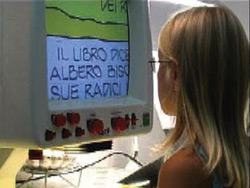World Sight Day
by Federico Bartolomei
Low vision and blindness, an emergence to keep an eye on.
On October 12, 2006, World Sight Day was celebrated in Italy under
the auspices of the International Agency for the Prevention of Blindness,
Italian division, in collaboration with Christian Blind Mission International of
Italy.
World Sight Day was celebrated in Italy under
the auspices of the International Agency for the Prevention of Blindness,
Italian division, in collaboration with Christian Blind Mission International of
Italy.
The following numbers support the scope of the problem: there are
in Italy nearly 350,000 blind people and more than one million and a half people
living with low vision, this latter group growing rapidly because of the
increase average of life expectancy; little more than 30% of children are
evaluated at birth; and almost 30% of students in elementary schools have not
undergone exams with an eye specialist. As far as adults are concerned, nearly
one million people live with glaucoma and half of them are not aware of it; it
is estimated that almost 5 to 10% of the population over 75 years of age are
affected by age-related macular degeneration. The World Health Organization raises the
alarm by declaring that there are in the world 37 million blind persons and 124
million others living with low vision. Ninety percent of blind people
live in the poorest areas of the planet; in 75% of cases, blindness can be
avoided through treatment and with preventive measures. The most common
pathologies are: cataract which affects 20 million persons; trachoma which
affects 146 million people; onchocerciasis, an infectious disease
which has an impact on the life of 17 million people; xerophtalmia which
affects each year 350,000 children, while 4 million and a half people are blind
because of glaucoma. These numbers show the dramatic
impact of the phenomenon which could be curbed with simple prevention measures,
since the greater part of visual pathologies are curable and preventable with
well-timed treatments.
These numbers show the dramatic
impact of the phenomenon which could be curbed with simple prevention measures,
since the greater part of visual pathologies are curable and preventable with
well-timed treatments.
Epidemiological studies lead in the city
of Bologna at the Istituto Cavazza have brought to the fore a high degree of
problems in various sectors of the population: in
2002, the prevention campaign "Light Eyes", which involved the entire school
population of the city of Bologna, highlighted that 17.2% of children
presented abnormal sight in various degrees which was not known about.
in
2002, the prevention campaign "Light Eyes", which involved the entire school
population of the city of Bologna, highlighted that 17.2% of children
presented abnormal sight in various degrees which was not known about.
In 2005, with the sight
prevention program "Grey Eyes",
a sample of older adults aged in average 70.9 years were evaluated: 8.5%
of the population which underwent exams expressed that they had never had an
appointment with an eye specialist while in 23% of cases, the glasses used did
not correspond to the actual optical needs of the users.
Alarming results
were obtained in the prevention campaign "Sport Eyes" in 2006 which involved
Bolognese sportspersons aged on average 27 years: in nearly 22% of cases during the exams,
the subjects did not reach the threshold of 10/10 in both eyes and 18.37% of
interviewed persons have declared that they had not seen an eye specialist to
undergo a complete set of exams in more than 12 years.